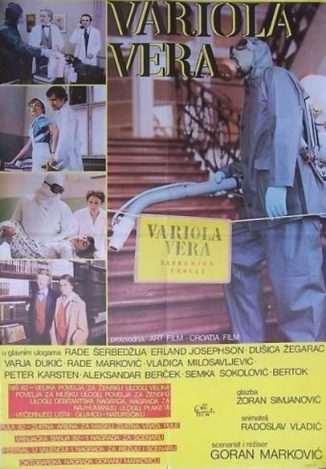 From the former Yugoslavia, a fact-based dramatization of the 1972 smallpox epidemic that occurred in Kosovo and Belgrade. This 1982 film, directed by one of Serbia’s top filmmakers Goran Markovic (of the classics SPECIAL EDUCATION and DÉJÀ VU), is widely considered one of the finest dramas to come out of Yugoslavia. VARIOLA VERA is indeed an impressive film, even if it isn’t as strong as it once was.
From the former Yugoslavia, a fact-based dramatization of the 1972 smallpox epidemic that occurred in Kosovo and Belgrade. This 1982 film, directed by one of Serbia’s top filmmakers Goran Markovic (of the classics SPECIAL EDUCATION and DÉJÀ VU), is widely considered one of the finest dramas to come out of Yugoslavia. VARIOLA VERA is indeed an impressive film, even if it isn’t as strong as it once was.
Amid the daily bustle of a Belgrade Hospital–whose residents include Dr. Markovic, who has a heart condition, the flirty Dr. Grujic and Danka, an attractive nurse who’s lusted after by seemingly every guy in sight—a severely ill man named Rejepi is admitted. Rejepi is a Muslim clergyman whose body is littered with ugly lesions, which the head doctor initially diagnoses as a reaction to penicillin. Shortly after this Rejepi expires, but not until after getting up from his bed and dripping blood everywhere.
Kostic, an aging scientist, is called in to properly diagnose the dead man, and he proclaims it variola—Latin for smallpox. In short order the hospital is quarantined, much to the consternation of the patients trapped inside, and a hazmat suit wearing epidemiologist (a smallpox survivor himself) is called in to keep an eye on things. Everyone is forced to get vaccinated, but several patients have illnesses that prevent the vaccine from doing its job.
Nor does the vaccine help those who already have variola, such as a young boy on the hospital’s second floor. This leads to the evacuation of the second floor’s healthy patients as order breaks down and Dr. Grujic grows extremely abusive. And still more smallpox afflicted patients turn up…
The surviving prints of VARIOLA VERA are extremely poor, with faded colors and scratched-up film stock, but Goran Markovic’s artful visual eye still shines through (a POV tracking shot through a hallway lined with smallpox afflicted patients remains a standout visual moment). Another dated aspect is the dull “human drama” of the early scenes, which includes some supposed-to-be-humorous banter about STD-afflicted patients.
The major critique that has dogged this otherwise highly acclaimed film is that it takes a number of liberties with the facts of the case upon which it was based. Despite the horror movie trappings (such as the Ominous music cues used to announce the possibility of smallpox affliction) and air of overheated melodrama (the performances, in keeping with the acting style favored by late Twentieth Century Yugoslavian cinema, tend toward the overwrought), it is a fairly realistic portrayal of a disease outbreak that takes into account the media portrayal of the event and the political ramifications. Plus the make-up effects, depicting the ravages of variola on various peoples’ faces and bodies, are horrifically impressive.
In light of the unspeakable realities of a pandemic (about which we’re now all experts), the contained setting seems rather quaint. There are, however, some uncomfortably close-to-home details, such as the concept of certain patients–in this case politicians’ relatives—getting released from quarantine simply because of their privileged status. Truly, some things never change.
Vital Statistics
VARIOLA VERA
Art Film 80/Croatia Film
Director: Goran Markovic
Producer: Aleksandar Stojanovic
Screenplay: Goran Markovic, Milan Nikolic
Cinematography: Radoslav Valdic
Editing: Vuksan Lukovac
Cast: Rade Serbedzija, Erland Josephson, Desica Zegarac, Varja Djukic, Rade Markovic, Vladislava Milosavljevic, Peter Carsten, Aleksandar Barcek, Radmila Zivkovic, Semka Sokolovic-Bertok, Bogdan Diklic, Velimir Zivotic, Milo Miranovic
